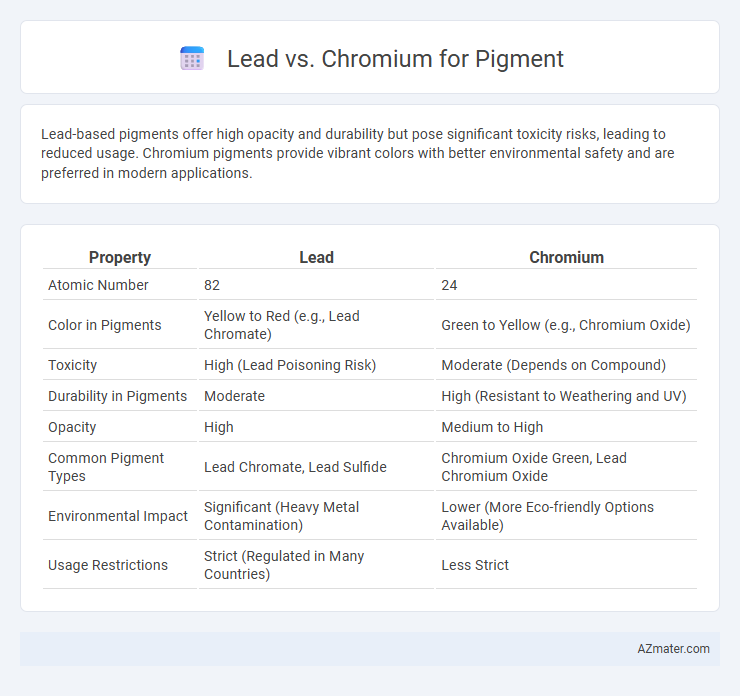Lead-based pigments offer high opacity and durability but pose significant toxicity risks, leading to reduced usage. Chromium pigments provide vibrant colors with better environmental safety and are preferred in modern applications.
Table of Comparison
| Property | Lead | Chromium |
|---|---|---|
| Atomic Number | 82 | 24 |
| Color in Pigments | Yellow to Red (e.g., Lead Chromate) | Green to Yellow (e.g., Chromium Oxide) |
| Toxicity | High (Lead Poisoning Risk) | Moderate (Depends on Compound) |
| Durability in Pigments | Moderate | High (Resistant to Weathering and UV) |
| Opacity | High | Medium to High |
| Common Pigment Types | Lead Chromate, Lead Sulfide | Chromium Oxide Green, Lead Chromium Oxide |
| Environmental Impact | Significant (Heavy Metal Contamination) | Lower (More Eco-friendly Options Available) |
| Usage Restrictions | Strict (Regulated in Many Countries) | Less Strict |
Introduction to Lead and Chromium Pigments
Lead pigments, primarily comprising lead white (basic lead carbonate) and lead chromate, are renowned for their excellent opacity, durability, and vibrant color intensity, especially in oil-based paints. Chromium pigments, such as chrome yellow (lead chromate variants without lead) and chromium oxide green, offer superior chemical stability, non-toxicity, and resistance to UV degradation, making them ideal for eco-friendly applications. Both pigments have played crucial roles in art and industry, with lead pigments historically preferred for brightness and opacity, whereas chromium pigments are favored today for their environmental safety and longevity.
Historical Usage of Lead and Chromium in Pigments
Lead-based pigments, such as lead white and lead chromate, were widely used historically for their durability and vibrant colors, especially in oil paints and industrial coatings. Chromium pigments, including chromium oxide green and chrome yellow, emerged in the 19th century as more stable and less toxic alternatives, gradually replacing many lead compounds in artistic and commercial applications. The shift from lead to chromium pigments was driven by health concerns and improved chemical properties that offered enhanced colorfastness and environmental safety.
Chemical Properties and Composition
Lead-based pigments, primarily lead chromate (PbCrO4), exhibit intense yellow hues due to the high atomic weight of lead and its ability to form stable compounds with chromium. Chromium pigments, such as chromium oxide green (Cr2O3), are valued for their excellent chemical stability, non-toxicity, and resistance to heat and acids. The key chemical distinction lies in lead pigments containing Pb2+ ions combined with CrO4^2- ions, whereas chromium pigments mainly consist of Cr3+ ions in oxide form, influencing their colorfastness and environmental impact.
Color Qualities and Applications
Lead-based pigments, such as lead chromate, offer vibrant yellow hues with exceptional opacity and excellent durability, making them ideal for industrial coatings and artist paints. Chromium pigments, including chromium oxide green, provide stable, non-toxic green shades with high resistance to heat and chemical exposure, commonly used in ceramics, plastics, and automotive finishes. The choice between lead and chromium pigments depends on desired color intensity, durability requirements, and safety considerations, with chromium pigments preferred for environmentally safer applications.
Toxicity and Health Implications
Lead pigments, such as lead chromate, pose significant health risks due to their high toxicity, causing neurological damage, kidney failure, and reproductive issues upon exposure. Chromium, particularly hexavalent chromium found in some pigments, is a known carcinogen linked to lung cancer and skin ulcers, with strict regulatory limits enforced globally. Both lead and chromium pigments require careful handling and substitution efforts to minimize environmental contamination and human health hazards.
Environmental Impact and Regulations
Lead-based pigments, historically valued for their vibrant colors and durability, pose significant environmental hazards due to their toxicity and persistence in ecosystems, leading to soil and water contamination. Chromium pigments, particularly those using hexavalent chromium, also present environmental risks but are subject to stringent regulations such as REACH and the U.S. EPA's standards that limit their usage and promote safer alternatives like trivalent chromium. Regulatory frameworks increasingly favor chromium pigments with lower toxicity profiles over lead pigments, driving innovation in environmentally safer pigment technologies.
Durability and Stability of Pigments
Lead pigments exhibit excellent durability and high resistance to environmental degradation, making them suitable for long-lasting applications in paints and coatings. Chromium pigments, particularly chromium oxide green, provide superior chemical stability, UV resistance, and weathering performance, ensuring vibrant colors that do not fade easily over time. While lead pigments offer robustness, chromium pigments are preferred for eco-friendly formulations due to their lower toxicity and enhanced stability under harsh conditions.
Industry Preferences and Alternatives
Lead-based pigments, historically favored for their opacity and durability, face declining industry preference due to toxicity and regulatory restrictions. Chromium pigments, especially chromium oxide green, offer greater environmental safety and chemical stability, making them a preferred alternative in coatings and plastics. Growing demand for non-toxic, sustainable materials drives industries to adopt chromium pigments and explore alternatives like iron oxide and organic pigments.
Innovations in Pigment Technology
Innovations in pigment technology have driven a shift from toxic lead-based pigments to safer chromium-based alternatives, enhancing color stability and environmental compliance. Chromium pigments, such as chromium oxide green and chromium hydroxide, offer superior durability, heat resistance, and non-toxicity compared to traditional lead pigments. Advanced synthesis methods and nano-engineering of chromium pigments improve their dispersion and brightness, making them preferred choices in coatings, plastics, and paints.
Future Trends in Pigment Materials
Lead-based pigments are increasingly replaced by chromium-based alternatives due to stringent environmental regulations and toxicity concerns associated with lead compounds. Chromium pigments, particularly chromium oxide and chromium hydroxide, offer enhanced stability, vibrant coloration, and improved resistance to UV degradation, aligning with the demand for sustainable and durable materials in coatings and plastics. Emerging research focuses on nano-crystalline chromium pigments to boost performance while minimizing ecological impact, signaling a future shift towards eco-friendly, high-performance pigment technologies.

Infographic: Lead vs Chromium for Pigment
 azmater.com
azmater.com